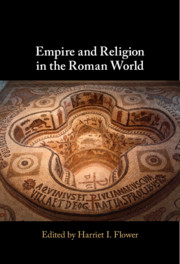Book contents
- Empire and Religion in the Roman World
- Empire and Religion in the Roman World
- Copyright page
- Frontispiece
- Contents
- Figures
- Table
- Contributors
- Acknowledgments
- Introduction
- Part I Empire
- Part II Religion
- Chapter 5 The First Christian Family of Egypt
- Chapter 6 Missionaries, Pious Merchants, Freelance Religious Experts, and the Spread of Christianity
- Chapter 7 Christian Piety in Late Antiquity
- Chapter 8 Ausonius at the Edge of Empire
- Chapter 9 Peregrinationes in Psalmos
- Chapter 10 Muḥammad’s Rivals
- Chapter 11 Brent Shaw
- Appendix: Bibliography of Brent D. Shaw’s Publications to 2020
- Index
- References
Chapter 6 - Missionaries, Pious Merchants, Freelance Religious Experts, and the Spread of Christianity
from Part II - Religion
Published online by Cambridge University Press: 26 August 2021
- Empire and Religion in the Roman World
- Empire and Religion in the Roman World
- Copyright page
- Frontispiece
- Contents
- Figures
- Table
- Contributors
- Acknowledgments
- Introduction
- Part I Empire
- Part II Religion
- Chapter 5 The First Christian Family of Egypt
- Chapter 6 Missionaries, Pious Merchants, Freelance Religious Experts, and the Spread of Christianity
- Chapter 7 Christian Piety in Late Antiquity
- Chapter 8 Ausonius at the Edge of Empire
- Chapter 9 Peregrinationes in Psalmos
- Chapter 10 Muḥammad’s Rivals
- Chapter 11 Brent Shaw
- Appendix: Bibliography of Brent D. Shaw’s Publications to 2020
- Index
- References
Summary
This chapter reviews the networks that made possible the diffusion of the beliefs and practices associated with the figure of Christ during the first and second centuries and concludes that the missionary, the pious merchant, and the occasional Christian traveler should definitively be discarded as likely agents of religious change. Complex contagions such as the diffusion of religious beliefs and practices require as agents individuals who have strong ties, and therefore social capital, in the different networks among which they circulate. In turn, the local networks of diffusion must be both strong-tie and sufficiently open. These findings invite a reopening of the question of the role of the Jewish Diaspora in the spread of Christianity beyond the first century.
- Type
- Chapter
- Information
- Empire and Religion in the Roman World , pp. 139 - 160Publisher: Cambridge University PressPrint publication year: 2021

